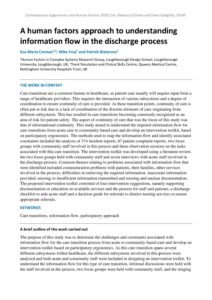| Document | Author Eva-Maria Carman, Mike Fray and Patrick Waterson |
| Abstract Care transitions are a common feature in healthcare, as patient care usually will require input from a range of healthcare providers. This requires the interaction of various subsystems and a degree of coordination to ensure continuity of care is provided. At these transition points, continuity of care is often put at risk due to a lack of coordination of the discrete elements of care originating from different subsystems. This has resulted in care transitions becoming commonly recognised as an area of risk for patient safety. The aspect of continuity of care that was the focus of this study was that of informational continuity. This study aimed to understand the required information flow for care transitions from acute care to community-based care and develop an intervention toolkit, based on participatory ergonomics. The methods used to map the information flow and identify associated constraints included the analysis of 374 incident reports, 87 patient complaint reports, two focus groups with community staff involved in this process and three observation sessions on the tasks associated with this care transition. The intervention toolkit was developed using a literature review, the two focus groups held with community staff and seven interviews with acute staff involved in the discharge process. Common themes relating to problems associated with information flow that were identified included communication problems with patients, their families, other services involved in the process; difficulties in retrieving the required information, inaccurate information provided; missing or insufficient information transmitted and missing and unclear documentation. The proposed intervention toolkit consisted of four intervention suggestions, namely supporting documentation or education on available services and the process for staff and patients, a discharge checklist to aide acute staff and a decision guide for referrals to district nursing services to ensure appropriate referrals. |

